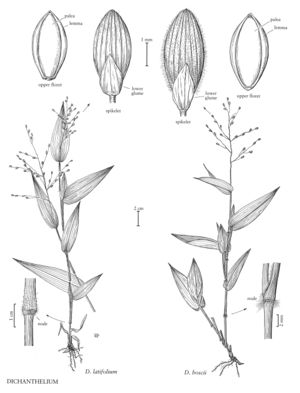Difference between revisions of "Dichanthelium latifolium"
FNA>Volume Importer |
imported>Volume Importer |
||
| (3 intermediate revisions by 2 users not shown) | |||
| Line 4: | Line 4: | ||
|publications= | |publications= | ||
|common_names=Broadleaved panicgrass;Panic à larges feuilles | |common_names=Broadleaved panicgrass;Panic à larges feuilles | ||
| + | |special_status={{Treatment/ID/Special_status | ||
| + | |code=E | ||
| + | |label=Endemic | ||
| + | }} | ||
|basionyms= | |basionyms= | ||
|synonyms={{Treatment/ID/Synonym | |synonyms={{Treatment/ID/Synonym | ||
| Line 24: | Line 28: | ||
-->{{Treatment/Body | -->{{Treatment/Body | ||
| − | |distribution=Conn.;N.J.;N.Y.;W.Va.;Del.;D.C;Wis.;Ont.;Que.;Mass.;Maine;N.H.;R.I.;Vt.;Tex.;N.C.;Tenn.;Pa.;Va.;Md.;Ala.;Ark.;Ill.;Ga.;Ind.;Iowa;Kans.;Nebr.;Okla.;Ohio;Mo.;Minn.;Mich.;Miss.;S.C.;Ky. | + | |distribution=Conn.;N.J.;N.Y.;W.Va.;Del.;D.C.;Wis.;Ont.;Que.;Mass.;Maine;N.H.;R.I.;Vt.;Tex.;N.C.;Tenn.;Pa.;Va.;Md.;Ala.;Ark.;Ill.;Ga.;Ind.;Iowa;Kans.;Nebr.;Okla.;Ohio;Mo.;Minn.;Mich.;Miss.;S.C.;Ky. |
|discussion=<p><i>Dichanthelium latifolium</i> grows in rich deciduous woods, often in slightly open areas within eastern North America. The primary panicles are open-pollinated and develop in May and June (and sometimes in September and October), the secondary panicles, which are produced from July through September, are rarely open-pollinated.</p> | |discussion=<p><i>Dichanthelium latifolium</i> grows in rich deciduous woods, often in slightly open areas within eastern North America. The primary panicles are open-pollinated and develop in May and June (and sometimes in September and October), the secondary panicles, which are produced from July through September, are rarely open-pollinated.</p> | ||
|tables= | |tables= | ||
| Line 42: | Line 46: | ||
|illustrator=Linda A. Vorobik;Hana Pazdírková | |illustrator=Linda A. Vorobik;Hana Pazdírková | ||
|illustration copyright=Utah State University | |illustration copyright=Utah State University | ||
| − | |distribution=Conn.;N.J.;N.Y.;W.Va.;Del.;D.C;Wis.;Ont.;Que.;Mass.;Maine;N.H.;R.I.;Vt.;Tex.;N.C.;Tenn.;Pa.;Va.;Md.;Ala.;Ark.;Ill.;Ga.;Ind.;Iowa;Kans.;Nebr.;Okla.;Ohio;Mo.;Minn.;Mich.;Miss.;S.C.;Ky. | + | |distribution=Conn.;N.J.;N.Y.;W.Va.;Del.;D.C.;Wis.;Ont.;Que.;Mass.;Maine;N.H.;R.I.;Vt.;Tex.;N.C.;Tenn.;Pa.;Va.;Md.;Ala.;Ark.;Ill.;Ga.;Ind.;Iowa;Kans.;Nebr.;Okla.;Ohio;Mo.;Minn.;Mich.;Miss.;S.C.;Ky. |
|reference=None | |reference=None | ||
|publication title= | |publication title= | ||
|publication year= | |publication year= | ||
| − | |special status= | + | |special status=Endemic |
| − | |source xml=https:// | + | |source xml=https://bitbucket.org/aafc-mbb/fna-data-curation/src/200273ad09963decb8fc72550212de541d86569d/coarse_grained_fna_xml/V25/V25_1134.xml |
|subfamily=Poaceae subfam. Panicoideae | |subfamily=Poaceae subfam. Panicoideae | ||
|tribe=Poaceae tribe Paniceae | |tribe=Poaceae tribe Paniceae | ||
Latest revision as of 18:55, 11 May 2021
Plants forming small clumps, with knotty rhizomes less than 2 mm thick. Basal rosettes well-differentiated; sheaths pubescent; blades ovate to lanceolate, dark green. Culms 45-110 cm, nearly erect; nodes glabrous or the lower nodes slightly bearded; internodes glabrous or sparsely pubescent; fall phase branching from the mid-culm nodes, branches nearly erect, scarcely rebranching, blades and secondary panicles only slightly reduced. Cauline leaves 4-6, often with a transitional leaf above the basal rosette; sheaths not overlapping, glabrous or softly villous basally, margins ciliate, collars pubescent; ligules 0.4-0.7 mm, membranous, ciliate, cilia longer than the membranous portion; blades 3.7-7 times longer than wide, 15-40 mm wide, ovate-lanceolate, glabrous or sparsely pubescent, with 11-13 major veins and 40-120 minor veins, bases cordate-clasping, with papillose-based cilia. Primary panicles 7-15 cm long, 4-12 cm wide, 1.5-2 times as long as wide, with 20-80 spikelets, eventually at least partially exserted; branches stiff, ascending to spreading. Spikelets 2.9-3.9 mm long, 1.6-2 mm wide, ellipsoid, sparsely pubescent. Lower glumes 1/3 – 1/2 as long as the spikelets, narrowly triangular; upper glumes and lower lemmas slightly shorter than the spikelets, often red-tinged basally and apically; lower florets staminate, anthers exserted prior to those of the upper florets; upper florets pointed, apiculate, upper lemmas with a minute fringe of hairs. 2n = 18, 36.
Distribution
Conn., N.J., N.Y., W.Va., Del., D.C., Wis., Ont., Que., Mass., Maine, N.H., R.I., Vt., Tex., N.C., Tenn., Pa., Va., Md., Ala., Ark., Ill., Ga., Ind., Iowa, Kans., Nebr., Okla., Ohio, Mo., Minn., Mich., Miss., S.C., Ky.
Discussion
Dichanthelium latifolium grows in rich deciduous woods, often in slightly open areas within eastern North America. The primary panicles are open-pollinated and develop in May and June (and sometimes in September and October), the secondary panicles, which are produced from July through September, are rarely open-pollinated.
Selected References
None.
